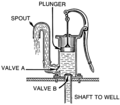Piston pump: Difference between revisions
BillBucket (talk | contribs) →Force pump: They're both a class of the same type of pump, no need to specify that the applications are similar. Clarified the valves. |
|||
| Line 12: | Line 12: | ||
===Force pump=== |
===Force pump=== |
||
In a force pump, the upstroke of the piston draws water, through |
In a force pump, the upstroke of the piston draws water, through an inlet valve, into the cylinder. On the downstroke, the water is discharged, through an outlet valve, into the outlet pipe. |
||
And this has the same mode of application as a lift pump..... |
|||
===Others=== |
===Others=== |
||
Revision as of 20:02, 20 December 2016

A piston pump is a type of positive displacement pump where the high-pressure seal reciprocates with the piston.[1] Piston pumps can be used to move liquids or compress gases. The first piston pump (called siphon) was invented by Ctesibius[2]
Types
The two main types of piston pump are the lift pump and the force pump.[3] Both types may be operated either by hand or by an engine.
-
Lift pump
-
Force pump
Lift pump
In a lift pump, the upstroke of the piston draws water, through a valve, into the lower part of the cylinder. On the downstroke, water passes through valves, set in the piston, into the upper part of the cylinder. On the next upstroke, water is discharged from the upper part of the cylinder via a spout.
Force pump
In a force pump, the upstroke of the piston draws water, through an inlet valve, into the cylinder. On the downstroke, the water is discharged, through an outlet valve, into the outlet pipe.


